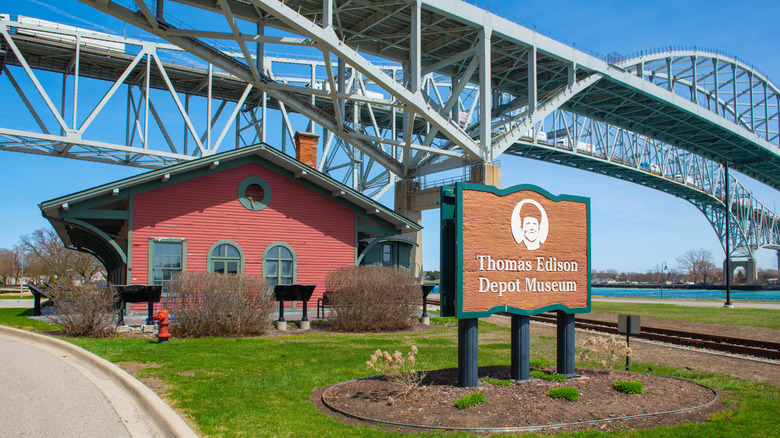The World's First Tunnel To Connect Two Countries Is In This Incredible Midwest State
Michigan is widely known for its contributions to cars in the 20th century. However, at the end of the 19th century, the state came into the spotlight with another modern engineering marvel that connected two countries via an underwater train tunnel. Nearly a century before the tunnel connecting England and France was built below the English Channel, engineers connected the U.S. and Canada under the St. Clair River, creating the world's first international tunnel. This 6,026-foot passageway, running from Port Huron, Michigan, to Sarnia, Ontario, operated for over 100 years, until it was closed off in 1994 after a modern replacement was constructed.
As far back as 1886, Grand Trunk Railway envisioned a submarine tunnel as the most economically viable and efficient way to keep trains moving between Chicago and Ontario. Grand Trunk's chief engineer, Joseph Hobson, led the construction; on both sides of the border, workers shoveled out clay by horse and buggy and erected a cast iron lining in an airlocked environment as they moved toward the middle, earning just a few cents an hour. When the tunnel was finished, both ends were misaligned by only 0.25 inches, proving that it was possible not only to construct an underwater railway tunnel through porous soil but also to remove water as a key bottleneck for passengers and cargo. Despite its significance as a National Historic Landmark and similar practices used in building New York's chaotic subway system a decade later, there are few markers other than a small green sign off 16th Street, at the entrance to Port Huron Station.
Incredible outdoor adventures on Michigan's Thumb
The St. Clair River is a 40-mile section of Lake Huron, forming part of the international border between the United States and Canada along Michigan's "Thumb Coast," the heart of the state's antique trail. Along with hidden gems in shops, Michigan's Lower Peninsula has a hidden trail network running across the state. From Port Huron, hop on Route One, the Great Lake-to-Lake Trail system running 275 miles between Lake Huron and Lake Michigan (or, in Michigander, from the outside of the thumb to below the pinky). Between the lakes, you'll have miles of beautiful, deep forests and state parks to explore, and you will never be more than a few miles from one of the state's 11,000 lakes. On your trip, be sure to stop in the charming city of Marshall and fuel up in one of the many tasty eateries along the way.
The 140 miles of coastline in Michigan's Thumb are largely rocky, making the region a rockhound's paradise. If you're adding to your collection, head to Lakeport State Park, 10 miles north of Port Huron, where you can comfortably camp by the lake. You may come across Petoskey stones, the state rock. If lazing the day away on the sand is more your style, visit Lighthouse Beach. While you're there, don't miss climbing to the top of Michigan's oldest lighthouse at Fort Gratiot and soaking in the dramatic views on both sides of the border, including the iconic Blue Water Bridge, the primary method to cross into Canada today.
Savor the past in Port Huron
Once you've made your way across the border, start your visit to the historic Port Huron with a ride on the city's classic Blue Water Trolleys, where you'll get a full one-hour tour of the downtown area for only a dime. Trips only run during the afternoon from June to September, but you'll get more than your money's worth, including a great lesson on the city's history. The charming downtown between the Black and St. Clair rivers boasts three entertainment venues, along with boutique hotels and dozens of restaurants and cafés. The area comes alive during Port Huron's annual boat week in July, capping off with the famed Bayview Mackinac Race across Lake Huron to Mackinac Island, a dreamy Victorian destination without cars.
One of America's most incredible minds, Thomas Edison, lived in Port Huron as a child. Train buffs as well as travelers curious about his life shouldn't miss the Thomas Edison Depot Museum, just footsteps from the Waterfront and the Huron Lightship, which illuminated sailors as they traveled through treacherous waters. About 1 mile south, you'll find Lynch's Irish Tavern, a classic Irish pub, and the Vintage Tavern, serving fresh, modern American cuisine in a building constructed in the 1800s.
Although you can still take Amtrak's Blue Water service from Chicago or Western Michigan, flying is likely much quicker if you're visiting from outside the state or North America. The closest major airport, Detroit Metro International Airport, is less than 80 miles away from the former iconic underwater tunnel.


